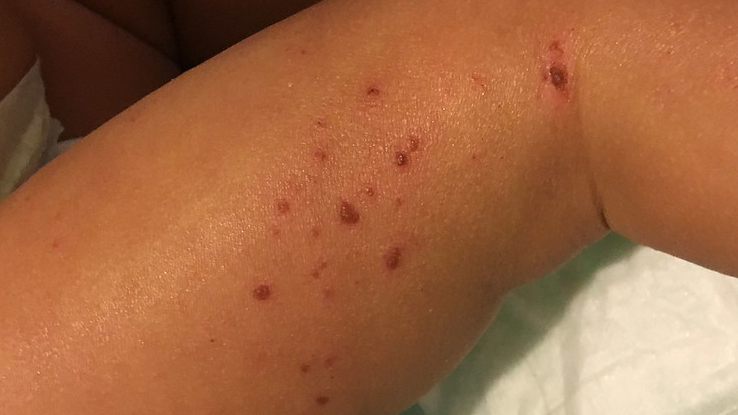Can Lack Of Vitamin D Cause Skin Rashes

Skin rashes can be irritating, and not just because of the physical discomfort many cause. Even with the internet, identifying them can be a challenge given how many kinds of rash are out there. However, while rare rash-inducing tropical diseases certainly exist, more often than not, skin conditions are the result of more ordinary causes. If you have a skin rash, the odds are good that it's the result of one of these conditions.
Also known as eczema, dermatitis and atopic eczema, atopic dermatitis (AD) is the scientific term for a severe and chronic form of eczema that appears as red and itchy patches of skin on the hands, feet, ankles, upper body and limbs. It's common in children and can flare up as early as the first two or three months of life. The skin becomes dry, scaly and itchy, and constant scratching may result in scabs or the skin darkening or lightening where the AD tends to spread. While it's rarer in adults, especially for a first case, it can happen. Between 10 and 20 percent of children and one to three percent of adults worldwide hav AD, and cases are increasing over time. Although the cause of AD is unknown, it's tied to genetics, allergies and the immune system. AD is not contagious.
While AD can improve or disappear over time, there is no known cure for it. However, there are ways to treat it. Over-the-counter and prescription lotions, phototherapy, and immunosuppressive and biologic drugs that prevent the immune system from inadvertently attacking the body can all help reduce symptoms and the frequency of breakouts. While certain steroids can be used in extreme cases, they're usually not recommended. People can also reduce their AD by avoiding potential triggers. While triggers vary from person to person, they may include stress, extreme temperatures and chemicals such as certain laundry detergents or hand soaps.
Psoriasis
Like all autoimmune disorders, psoriasis is caused by the immune system overreacting and targeting the body instead of harmful germs. In the case of psoriasis, the result is inflammation and fast turnover for skin cells, which in turn causes thick, scaly skin patches that feel itchy, dry, painful or even hot. It often appears on the scalp, face, elbows, lower back, hands, knees and feet, but it can also affect finger- and toenails, the mouth and more. 10 to 20 percent of people with psoriasis also go on to develop psoriatic arthritis. While psoriasis occurs mostly in adults, anyone can have this immune disorder. It's not contagious.
Treatment for psoriasis depends on its severity and location. Creams and ointments are usually applied to affected areas, and ultraviolet therapy may also be recommended. Medicines, including methotrexate, are often prescribed by a doctor.
Drug Rash
In many cases, a skin rash is the result of medication. They can vary greatly in size, area, color, appearance, severity and length; they can take the form of mild redness or swelling in a small area, or they can involve large amounts of peeling skin. Some appear immediately after taking a drug, while others appear days or even weeks later or are triggered by exposure to sunlight. Even mouth sores can be a form of drug rash.
Fortunately, many kinds of drug rash can be stopped simply by no longer taking the medication that triggered it. If the rash is bothersome, antihistamines and corticosteroid creams can help with the discomfort. However, if the rash is severe, it could need immediate medical attention. This is particularly true if it's accompanied by breathing problems.
Contact Dermatitis
Contact dermatitis occurs when you come into direct contact with a substance that irritates your skin, either as part of an allergic reaction or otherwise. Substances that can cause non-allergic contact dermatitis include solvents, sawdust and other airborne particles, rubbing alcohol, bleach and some other detergents, certain plants and some shampoos. Contact dermatitis may come with a red rash, inflammation, dry or cracked skin and bumps or blisters. People experiencing it may feel itching, burning or tenderness. While non-allergic contact dermatitis appears wherever you made contact with an irritating substance, the allergic variety can also appear on a small part of your body even if you ingested the allergen rather than touching it.
Treatment is usually as simple as avoiding contact with the substance in question and using ointments, cold and moist compresses and other remedies you can either buy at the drug store or make yourself. However, if the rash is sudden, painful or widespread, you may want to make an appointment with a doctor. This is also true if it affects the face or genitals, doesn't get better in three weeks or otherwise interferes with life. You should go to the doctor immediately if the rash causes an infection (often characterized by pus or blisters); damages the mucous lining of your mouth or digestive tract; or comes with inflammation or pain in the eyes, lungs or nose.
Ringworm
Tinea corporis (ringworm) is caused by a fungus that produces an itchy, red, raised rash in the form of a ring that expands as the infection spreads. Despite the name, this skin condition does not involve worms of any time and is instead just a fungus. It is highly contagious with skin-to-skin contact, so it's important to keep it covered. People without ringworm should avoid contact with unwashed clothing, bedding and towels from someone who does have it. Athlete's foot (which affects the feet) and jock itch (which affects the groin) are closely related.
Ringworm can be treated with ointments available for purchase in your local drugstore that contain clotrimazole, miconazole, ketoconazole or terbinafine. If ringworm persists or appears on the scalp, a doctor should be consulted. In that case, prescription fungicides may be needed.
Resource Links
https://nationaleczema.org/eczema/types-of-eczema/atopic-dermatitis/
https://www.aad.org/public/diseases/eczema/types/atopic-dermatitis/atopic-dermatitis-treatment
https://www.cdc.gov/psoriasis/index.htm
https://www.niams.nih.gov/health-topics/psoriasis#tab-treatment
https://www.merckmanuals.com/home/skin-disorders/hypersensitivity-and-inflammatory-skin-disorders/drug-rashes
https://www.mayoclinic.org/diseases-conditions/contact-dermatitis/symptoms-causes/syc-20352742
https://www.cdc.gov/fungal/diseases/ringworm/treatment.html
MORE FROM SYMPTOMFIND.COM
Can Lack Of Vitamin D Cause Skin Rashes
Source: https://www.symptomfind.com/health/types-skin-rashes-how-treat-them?utm_content=params%3Ao%3D740013%26ad%3DdirN%26qo%3DserpIndex
